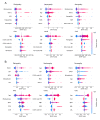Machine Learning for Predicting Micro- and Macrovascular Complications in Individuals With Prediabetes or Diabetes: Retrospective Cohort Study
- PMID: 36848190
- PMCID: PMC10012007
- DOI: 10.2196/42181
Machine Learning for Predicting Micro- and Macrovascular Complications in Individuals With Prediabetes or Diabetes: Retrospective Cohort Study
Abstract
Background: Micro- and macrovascular complications are a major burden for individuals with diabetes and can already arise in a prediabetic state. To allocate effective treatments and to possibly prevent these complications, identification of those at risk is essential.
Objective: This study aimed to build machine learning (ML) models that predict the risk of developing a micro- or macrovascular complication in individuals with prediabetes or diabetes.
Methods: In this study, we used electronic health records from Israel that contain information about demographics, biomarkers, medications, and disease codes; span from 2003 to 2013; and were queried to identify individuals with prediabetes or diabetes in 2008. Subsequently, we aimed to predict which of these individuals developed a micro- or macrovascular complication within the next 5 years. We included 3 microvascular complications: retinopathy, nephropathy, and neuropathy. In addition, we considered 3 macrovascular complications: peripheral vascular disease (PVD), cerebrovascular disease (CeVD), and cardiovascular disease (CVD). Complications were identified via disease codes, and, for nephropathy, the estimated glomerular filtration rate and albuminuria were considered additionally. Inclusion criteria were complete information on age and sex and on disease codes (or measurements of estimated glomerular filtration rate and albuminuria for nephropathy) until 2013 to account for patient dropout. Exclusion criteria for predicting a complication were diagnosis of this specific complication before or in 2008. In total, 105 predictors from demographics, biomarkers, medications, and disease codes were used to build the ML models. We compared 2 ML models: logistic regression and gradient-boosted decision trees (GBDTs). To explain the predictions of the GBDTs, we calculated Shapley additive explanations values.
Results: Overall, 13,904 and 4259 individuals with prediabetes and diabetes, respectively, were identified in our underlying data set. For individuals with prediabetes, the areas under the receiver operating characteristic curve for logistic regression and GBDTs were, respectively, 0.657 and 0.681 (retinopathy), 0.807 and 0.815 (nephropathy), 0.727 and 0.706 (neuropathy), 0.730 and 0.727 (PVD), 0.687 and 0.693 (CeVD), and 0.707 and 0.705 (CVD); for individuals with diabetes, the areas under the receiver operating characteristic curve were, respectively, 0.673 and 0.726 (retinopathy), 0.763 and 0.775 (nephropathy), 0.745 and 0.771 (neuropathy), 0.698 and 0.715 (PVD), 0.651 and 0.646 (CeVD), and 0.686 and 0.680 (CVD). Overall, the prediction performance is comparable for logistic regression and GBDTs. The Shapley additive explanations values showed that increased levels of blood glucose, glycated hemoglobin, and serum creatinine are risk factors for microvascular complications. Age and hypertension were associated with an elevated risk for macrovascular complications.
Conclusions: Our ML models allow for an identification of individuals with prediabetes or diabetes who are at increased risk of developing micro- or macrovascular complications. The prediction performance varied across complications and target populations but was in an acceptable range for most prediction tasks.
Keywords: diabetes; machine learning; macrovascular complications; microvascular complications; prediabetes.
©Simon Schallmoser, Thomas Zueger, Mathias Kraus, Maytal Saar-Tsechansky, Christoph Stettler, Stefan Feuerriegel. Originally published in the Journal of Medical Internet Research (https://www.jmir.org), 27.02.2023.
Conflict of interest statement
Conflicts of Interest: None declared.
Figures



References
-
- Deshpande AD, Harris-Hayes M, Schootman M. Epidemiology of diabetes and diabetes-related complications. Phys Ther. 2008 Nov;88(11):1254–64. doi: 10.2522/ptj.20080020. https://europepmc.org/abstract/MED/18801858 ptj.20080020 - DOI - PMC - PubMed
-
- Fowler M. Microvascular and macrovascular complications of diabetes. Clin Diabetes. 2011;29(3):116–22. doi: 10.2337/diaclin.29.3.116. - DOI

